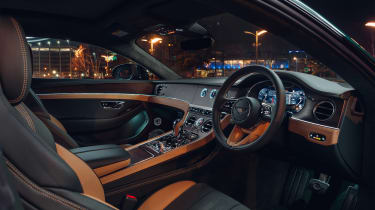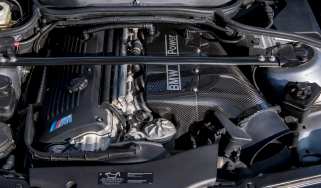Bentley Continental GT S 2023 review
New ‘S’ model gets no more power than regular V8, but subtle tweaks make it the pick of the range
Have you spotted the new trend among manufacturers who are preparing to end their association with the internal combustion engine and pledge their allegiance to the lithium-packed battery pack? We are firmly in the period of launching new performance models that have no more power or torque than existing or lesser models in the line-up with the same motor. Lamborghini has done it with its updated Urus, and now Bentley too. It’s no coincidence that they both use the same 4-litre twin-turbo V8.
Deadlines and commitments (largely self-imposed) to be predominantly or even 100 per cent electrified by a specific date mean the cost of developing more powerful derivatives that have such a potentially short shelf-life simply isn’t worth diverting the budget for.
> Bentley Continental R Mulliner: review, history and specs
In the case of Bentley, the introduction of the Continental GT S is to offer a more dynamic model rather than a faster one, to complement the luxury ethos behind the V8-only Azure and the bespoke nature of the Mulliner (available with a V8 or W12) but sitting below the range-topping W12 Speed. However, the only problem with manufacturer model hierarchies is that annoying journalists often ignore them. So while Bentley champions the W12 Speed as the ultimate Conti GT, we’ve always favoured the V8-engined models, and that’s unlikely to change with the S.
The obvious benefit is the 108kg weight saving the eight-cylinder car has over the soon-to-be-retired W12 (the V8 engine makes up 65kg of that saving). But there are also the characteristics of the smaller unit that strike a very fine and precise balance between refinement and effortless and meaningful performance. Add in what is beyond doubt the finest interior of any modern car and Bentley’s GT remains one of the most agreeable places to spend a lot of time. The S’s fluted sports seats, suede-trimmed steering wheel and sports instrument pack only add to the sense that, while there may be VW Group hardware in here, the finish is the highest example of craftsman – and woman – ship you’ll find in any car assembled on a production line.
More reviews
Group tests
In-depth reviews
Reviews
- Bentley Continental GT 2025 review – Crewe's DB12 rival has the Aston Martin licked
- Bentley Continental GT Speed 2025 review – driving the most powerful Bentley yet
- Bentley Continental GTC Speed 2025 review – huge power, huge weight, huge price
- Bentley Continental GT W12 (Mk1, 2003-2010): the car that saved Bentley
- New Bentley Continental GT hybrid prototype review: Bentley’s most powerful road car ever
Under the body, which wears black trim where Azure models are finished in chrome, remain the three-chamber air suspension system and 48-volt active anti-roll bars that underpin Bentley’s Dynamic Ride system, all parts of which have been very subtly tweaked and enhanced to provide the S with an edge and its own distinct personality.
It still rides with the expected hushed calmness of a GT, absorbing the surface beneath while retaining a connection that means you’re not totally isolated from what’s going on. Clearly it’s no 911, it doesn’t pretend to be, yet neither is there a sense of aloofness that you might expect of a car weighing nearly 2.1 tons. You can, however, feel the air springs earning their keep as they match body control to ride comfort, the inputs fluid and linear and accompanied by a feeling of technical solidity in everything the Panamera-based chassis is being asked to do.
Crunching big miles easily in a Conti GT is a given and, in a world of unreliable short-haul air travel, having the keys to an S might have you pointing its nose in the opposite direction from the airport when heading for the Continent. A road such as the B660 isn’t a great arena for it, not that you would expect it to be. Despite that lighter V8, the nose can be slow to respond and tuck in, the body finally giving in to its bulk, knowing it’s a battle lost.
However, in the middle ground on roads that ebb and flow, encourage momentum and allow a car to breathe and build to a gallop, the GT S reveals its winning hand. It’s now that the steering delivers its best weighting and rate of response, the eight-speed ZF and twin-turbo V8 striking up a seemingly irreproachable partnership.
Leave the drive mode in Comfort and the whole car feels totally within itself, an automotive demonstration of no effort required, and some may never feel the need to experiment further up the mode dial. Yet select Sport and the S picks up its technical toys to play harder. A tightness is applied to the damping and steering; the throttle and transmission sharpen and the car feels on its toes. On poorer surfaces, Sport’s chassis settings might be too tight for some, with low-frequency vibrations percolating through the steering and your backside, but the car’s Individual mode allows you to wind them back to Comfort while keeping the rest wound up.
Price and rivals
It’s not razor-sharp like Ferrari’s Roma, nor does it enjoy the agility of a DB11, but the Bentley is happy to leave its rivals to their performance agendas and step into the classical GT tracks. Without the active rear diff or four-wheel steering of the GT Speed, the £198,600 GT S doesn’t have that final layer of dynamic polish, but a V8-engined Conti GT remains our pick, especially so the S.
Bentley Continental GT S specs
| Engine | V8, 3996cc twin-turbo |
| Power | 542bhp @ 6000rpm |
| Torque | 568lb ft @ 2000-4500rpm |
| Weight | 2090kg (263bhp/ton) |
| Top speed | 198mph |
| 0-62mph | 4.0sec |
| Basic price | £198,600 |
This story was first featured in evo issue 309.







